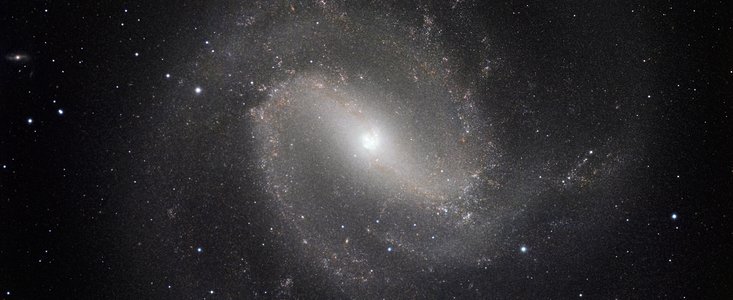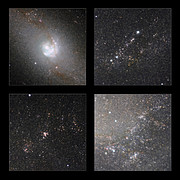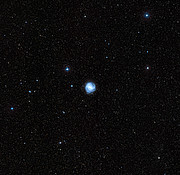Komunikat prasowy
Clear New View of a Classic Spiral
19 maja 2010
ESO is releasing a beautiful image of the nearby galaxy Messier 83 taken by the HAWK-I instrument on ESO’s Very Large Telescope (VLT) at the Paranal Observatory in Chile. The picture shows the galaxy in infrared light and demonstrates the impressive power of the camera to create one of the sharpest and most detailed pictures of Messier 83 ever taken from the ground.
The galaxy Messier 83 (eso0825) is located about 15 million light-years away in the constellation of Hydra (the Sea Serpent). It spans over 40 000 light-years, only 40 percent the size of the Milky Way, but in many ways is quite similar to our home galaxy, both in its spiral shape and the presence of a bar of stars across its centre. Messier 83 is famous among astronomers for its many supernovae: vast explosions that end the lives of some stars. Over the last century, six supernovae have been observed in Messier 83 — a record number that is matched by only one other galaxy. Even without supernovae, Messier 83 is one of the brightest nearby galaxies, visible using just binoculars.
Messier 83 has been observed in the infrared part of the spectrum using HAWK-I [1], a powerful camera on ESO’s Very Large Telescope (VLT). When viewed in infrared light most of the obscuring dust that hides much of Messier 83 becomes transparent. The brightly lit gas around hot young stars in the spiral arms is also less prominent in infrared pictures. As a result much more of the structure of the galaxy and the vast hordes of its constituent stars can be seen. This clear view is important for astronomers looking for clusters of young stars, especially those hidden in dusty regions of the galaxy. Studying such star clusters was one of the main scientific goals of these observations [2]. When compared to earlier images, the acute vision of HAWK-I reveals far more stars within the galaxy.
The combination of the huge mirror of the VLT, the large field of view and great sensitivity of the camera, and the superb observing conditions at ESO’s Paranal Observatory makes HAWK-I one of the most powerful near-infrared imagers in the world. Astronomers are eagerly queuing up for the chance to use the camera, which began operation in 2007 (eso0736), and to get some of the best ground-based infrared images ever of the night sky.
Uwagi
[1] HAWK-I stands for High-Acuity Wide-field K-band Imager. More technical details about the camera can be found in an earlier press release (eso0736).
[2] The data used to prepare this image were acquired by a team led by Mark Gieles (University of Cambridge) and Yuri Beletsky (ESO). Mischa Schirmer (University of Bonn) performed the challenging data processing.
Więcej informacji
ESO, the European Southern Observatory, is the foremost intergovernmental astronomy organisation in Europe and the world’s most productive astronomical observatory. It is supported by 14 countries: Austria, Belgium, Czechia, Denmark, France, Finland, Germany, Italy, the Netherlands, Portugal, Spain, Sweden, Switzerland and the United Kingdom. ESO carries out an ambitious programme focused on the design, construction and operation of powerful ground-based observing facilities enabling astronomers to make important scientific discoveries. ESO also plays a leading role in promoting and organising cooperation in astronomical research. ESO operates three unique world-class observing sites in Chile: La Silla, Paranal and Chajnantor. At Paranal, ESO operates the Very Large Telescope, the world’s most advanced visible-light astronomical observatory and VISTA, the world’s largest survey telescope. ESO is the European partner of a revolutionary astronomical telescope ALMA, the largest astronomical project in existence. ESO is currently planning a 42-metre European Extremely Large optical/near-infrared Telescope, the E-ELT, which will become “the world’s biggest eye on the sky”.
Kontakt
Richard Hook
ESO
Garching, Germany
Tel.: +49 89 3200 6655
E-mail: rhook@eso.org
O komunikacie
| Komunikat nr: | eso1020 |
| Nazwa: | M 83 |
| Typ: | Local Universe : Galaxy : Type : Spiral |
| Facility: | Very Large Telescope |
| Instrumenty: | HAWK-I |







